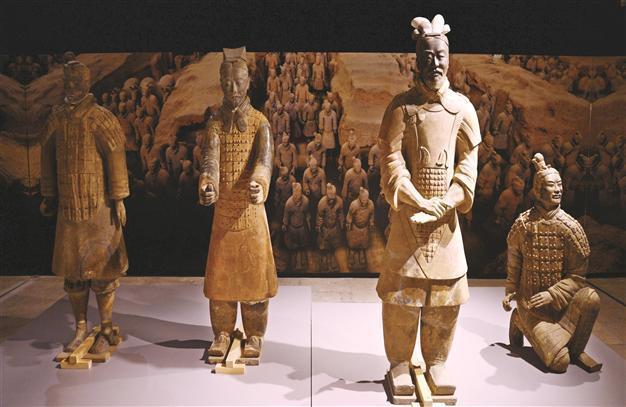Chinese world heritage relics at Topkapı Museum
ISTANBUL - Hürriyet Daily News

The terracotta soldiers are considered one of the world’s eight wonders, and they are rarely taken out of China. A horse sculpture, which has never left China, has been brought to Istanbul for the exhibition. AA photo
Five of China’s famous terracotta sculptures, which belong to UNESCO’s World Heritage List, are on display at an exhibition titled “Chinese Treasures,” which opened Nov. 21 at Istanbul’s Topkapı Palace Museum. According to Chinese law, bringing more than five terracotta soldiers out of the country is prohibited.
Culture and Tourism Minister Ertuğrul Günay, who opened the exhibition, was welcomed by the Ottoman Janissary Band at the entrance of the museum. Highlighting the importance of displaying the 5,000-year-old Chinese cultural relics in Istanbul, Günay said, “We wanted to welcome this nice event with such a surprise. This is the first time that the Ottoman Janissary Band has performed at the opening of an exhibition here. But we thought that the Ottoman Band should lead the way for the Chinese empire soldiers.”
Günay said that in the exhibition, which also features 101 other pieces from Chinese museums, the terracotta soldiers draw the greatest interest. He said 2012 is being celebrated as the Chinese Year in Turkey, and “We will try to promote Turkey in China in 2013 with various organizations and art events.”
After an inaugural speech, Günay opened the exhibition with officials from China including the Chinese Consul General to Istanbul Zhang Qingyang and China’s Cultural Heritage Department Chairman Li Xiaojie, as well as Istanbul Mayor Hüseyin Avni Mutlu.
A special air-conditioning and lightning system has been established in the Has Ahırlar area of the Topkapa Palace Museum to accommodate the relics.
Topkapı Palace Museum President Haluk Dursun said the “Chinese Treasures” exhibition is a very comprehensive display to promote Chinese culture in Turkey, and as the terracotta soldiers are considered one of the world’s eight wonders, they are rarely taken out of China. Four soldiers with different features and a horse sculpture, which has never left China, were brought to Istanbul for the show.
Each sculpture has different hair style“Experts of the Topkapı Palace and ones from China carried out very delicate and serious work in the palace for the exhibition. As well as displaying the artwork, bringing them here and sending them back to their country is very important. This is why this exhibition is a very delicate one. Experts pay the utmost attention to the artwork. They have taken very detailed measures regarding how to display them. Conditions in which to keep these pieces have been previously determined,” Dursun said, adding that the exhibition gained depth with mirrors and posters.
The Terracotta Army, also known as the “Terra Cotta Warriors and Horses,” is a form of funerary art that was buried with Qin Shi Huang in 210–209 BC for the purpose of protecting the emperor in his afterlife. The figures, dating from the third century BC, were discovered in 1974 by local farmers in the Lintong District of Xi’an in Shaanxi province. The figures vary in height according to their roles, with the tallest being the generals, and include warriors, chariots and horses. In the three pits containing the Terracotta Army there are an estimated 8,000 soldiers and 130 chariots with 520 horses and 150 cavalry horses, the majority of which are still buried near Qin Shi Huang’s mausoleum. Other non-military terracotta figures were also found including officials, acrobats, strongmen and musicians.
One of the notable features of the Terracotta Army soldiers is that each has different hair style. The shortest sculpture is approximately 1.70 meters and the longest one is 1.90 meters, the real height of the soldiers during the Qin dynasty.
The exhibition, which displays artwork from 11 important Chinese museums including the Forbidden City Museum, Shanghai Museum and Qin Shihuang Museum, will continue through Feb. 23, 2013.
